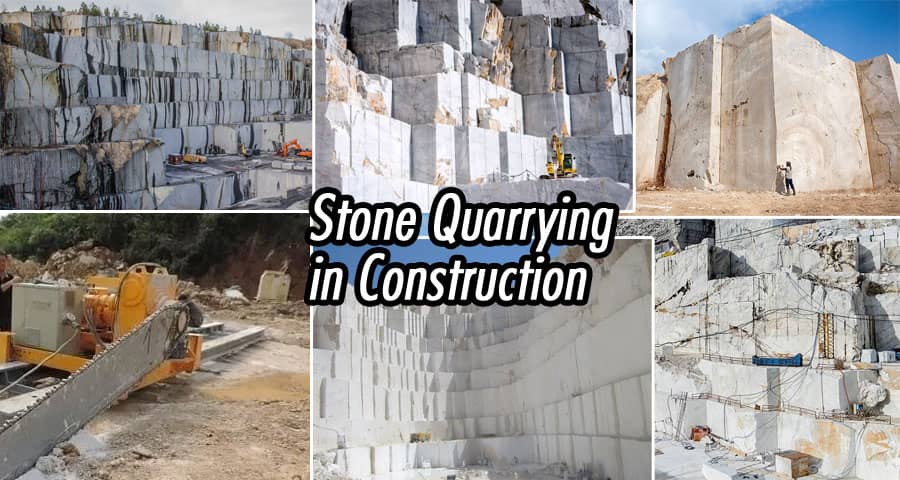Stone Quarrying in Construction: Methods, equipment uses and site selection

Introduction
Stone quarrying plays a vital role in the construction industry as it provides a reliable and abundant supply of stone materials. These materials are essential for various construction projects such as buildings, roads, bridges, and landscaping.
The Importance of Stone Quarrying in Construction
Stone quarrying is crucial in the construction industry due to the following reasons:
- Abundant Material: Stone quarries provide an abundant supply of natural stone, which is a versatile and durable material widely used in construction.
- Variety of Applications: Stones extracted from quarries can be used for various purposes, including aggregate production, dimension stone for building facades, decorative purposes, and landscaping.
- Economic Significance: Stone quarrying creates job opportunities, stimulates local economies, and contributes to the growth of the construction industry.
Methods of Stone Quarrying
There are several methods used in stone quarrying, each with its own advantages and suitability based on the geological characteristics of the site. The most common methods include:
- Explosive Method: The explosive method involves drilling holes into the rock formation and inserting explosives. The detonation of the explosives fractures the rock, allowing for easier extraction. This method is effective for large-scale quarrying operations and is commonly used for obtaining dimension stone blocks.
- Drilling and Wedging Method: The drilling and wedging method is employed for softer stone formations. It involves drilling holes along the desired line of quarrying and then inserting wedges and feathers into the holes. By striking the wedges, the stone is gradually split along its natural planes.
- Channeling Method: The channeling method is suitable for extracting stone from narrow and deep quarry beds. In this method, channels are cut into the rock using chisels and hammers. The stone is gradually separated by repeatedly driving wedges into the channels until it detaches from the bedrock.
Equipment Used in Stone Quarrying
Stone quarrying requires specialized equipment to enhance productivity and ensure efficient extraction. Some commonly used equipment includes:
- Excavators: Excavators are heavy machinery used for removing overburden and extracting large stone blocks. They offer versatility and maneuverability, making them essential in quarrying operations.
- Bulldozers: Bulldozers are used to clear the land and create access roads within the quarry. They are crucial for site preparation and material handling.
- Crushers: Crushers are utilized to break down large stone blocks into smaller pieces suitable for various construction applications. They come in different types, such as jaw crushers, impact crushers, and cone crushers.
- Quarry Wire Saws: Quarry wire saws are used for precise cutting of stone blocks. They utilize diamond wires to create clean and accurate cuts, allowing for efficient extraction of dimension stones.
Site Selection for Stone Quarrying
Proper site selection is crucial for successful stone quarrying in construction. The following factors are considered during site selection:
- Geological Assessment: A thorough geological assessment of the potential quarry site is essential. Factors such as rock quality, stability, and availability of suitable stone deposits are evaluated to ensure long-term viability.
- Environmental Considerations: Environmental considerations are critical to minimize the impact of quarrying activities. Factors like water availability, nearby habitats, and potential disturbance to ecosystems are taken into account. Sustainable practices are implemented to mitigate any adverse effects.
- Proximity to Construction Site: The proximity of the quarry to the construction site affects transportation costs and logistics. Selecting a site close to the construction project minimizes transportation expenses and ensures a timely supply of materials.
Advantages and Challenges of Stone Quarrying
Stone quarrying offers several advantages, including:
- Access to abundant natural resources
- Wide variety of stone types for different applications
- Economic benefits for local communities
However, there are also challenges associated with stone quarrying, such as:
- Environmental impacts, including habitat destruction and landscape alteration
- Noise and dust pollution
- Rehabilitation and restoration of quarried areas
Conclusion
Stone quarrying plays a pivotal role in the construction industry by providing essential construction materials. The methods and equipment used, along with careful site selection, ensure the efficient extraction of stone resources. However, it is important to balance the benefits of stone quarrying with environmental considerations and adopt sustainable practices to minimize its impact on the ecosystem.
FAQs
Can stone quarrying be done manually without any equipment?
No, stone quarrying on a significant scale requires specialized equipment for efficient extraction and productivity. Manual methods are limited to small-scale operations.
What are the different types of stone products obtained from quarries?
Stone quarries produce various products, including crushed stone, dimension stone blocks, landscaping stones, and decorative stones.
How is stone quality assessed in a potential quarry site?
Stone quality is assessed through geological surveys, laboratory testing, and analyzing physical properties such as strength, durability, and weathering resistance.
Are there any regulations in place to control stone quarrying activities?
Yes, most countries have regulations and permits in place to govern stone quarrying activities. These regulations aim to ensure environmental protection, worker safety, and sustainable practices.
What happens to a quarry site after the stone extraction is completed?
Quarry sites are rehabilitated and restored to mitigate the environmental impact. This involves backfilling, recontouring, and replanting vegetation to restore the site's natural balance.
